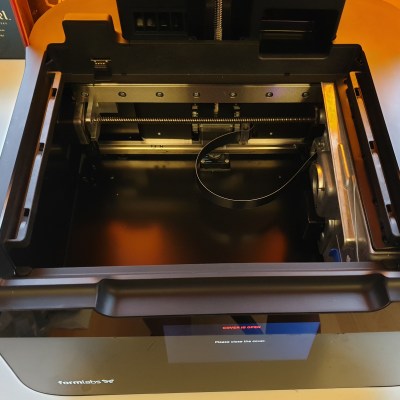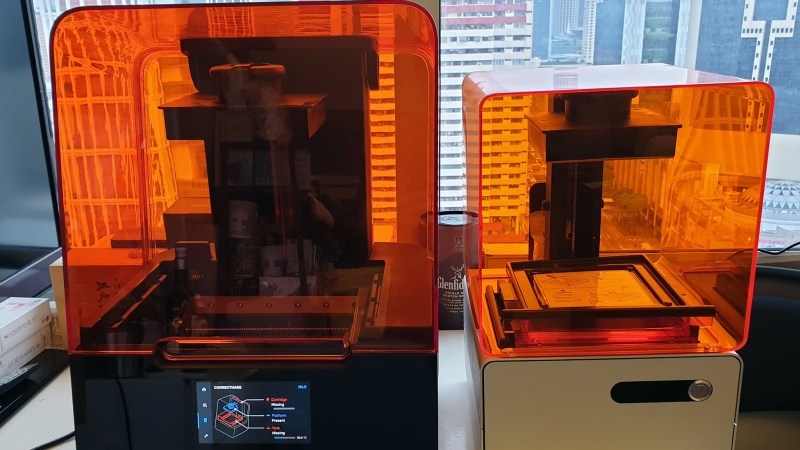[Bunnie Huang] has shared with all of us his utterly detailed teardown on the Form 3 SLA printer from Formlabs (on the left in the image above) and in it he says one of the first things he noticed when he opened it to look inside was a big empty space where he expected to see mirrors and optics. [Bunnie] had avoided any spoilers about the printer design and how it worked, so he was definitely intrigued.

Not only does the teardown reveal the kind of thoughtful design and construction that [Bunnie] has come to expect of Formlabs, but it reveals that the Form 3 has gone in an entirely new direction with how it works. Instead of a pair of galvanometers steering a laser beam across a build surface (as seen in the Form 1 and Form 2 printers) the new machine is now built around what Formlabs calls an LPU, or Light Processing Unit, which works in conjunction with a new build tank and flexible build surface. In short, the laser and optics are now housed in a skinny, enviromentally-sealed unit that slides left and right within the printer. A single galvo within steers the laser vertically, as the LPU itself moves horizontally. Payoffs from this method include things such as better laser resolution, the fact that the entire optical system is no longer required to sit directly underneath a vat of liquid resin, and that build sizes can be bigger. In addition, any peeling forces that a model is subjected to are lower thanks to the way the LPU works.
Details about exactly how the Form 3 works are available on Formlabs’ site and you can also see it in action from a practical perspective on Adam Savage’s Tested (video link), but the real joy here is the deeply interesting look at the components and assembly through the eyes of someone with [Bunnie]’s engineering experience. He offers insights from the perspective of function, supply, manufacture, and even points out a bit of NASA humor to be found inside the guts of the LPU.
[Bunnie] knows his hardware and he’s certainly no stranger to Formlabs’ work. His earlier Form 2 teardown was equally detailed as was his Form 1 teardown before that. His takeaway is that the Form 3 and how it works represents an evolutionary change from the earlier designs, one he admits he certainly didn’t see coming.















The Form 3 is the first 3D printer I’ve owned (I’ve used various FDM printers, but they have always disappointed me). All in all I am glad I waited for one. It’s not perfect, but I am happy with the trade offs versus FDM.
So with the LPU design the resolution on X and Y axis would be different no? One axis is driven by the galvo the other by the stepper motor dragging the LPU along.
I suppose that the difference in max resolution can be compensated in software by limiting/quantizing the galvo down to match the stepper as much as possible.
I think a lot of threaded rod steppers get accuracy down to below 0.05mm.
What’s the size of the laserdot?
I think that would be the ultimate determining factor, though I guess it’s possible to overlap for some fraction of dot size.
Does it still lock out features when in open resin mode, or is it a product I would even consider buying now?
Very happy with my Peopoly printer. We must categorically reject vendor lock-in in 3D printing consumables, or we will lose 3D printing like we (the consumer) lost inkjet and laser printing.
I agree. Dealing with 3rd party materials for inkjets has become awful.
Why do they still use galvos? In a photocopier, there is a constantly spinning hexagonal mirror and the laser is shut on and of when necessary.
In a resin printer, you want to be able to control the amount of time the laser spends at each point (according to the needs of the specific resin you are using). I expect there are tradeoffs that made them choose the galvo. For the spinning mirror, your resolution is limited by the electronic’s switching speed.
There must be some benefit of using a galvo which can produce a continuous vector over spinning mirrors which would be discontinuous, producing a raster instead. My guess is the repeatability and resolution are greater for a galvo. A spinning mirror system would be highly timing dependent, easily affected by clock jitter and position detection errors and depending on the size/shape of what is being drawn has variable duty and delay between scanned lines. A galvo on the other hand has very precise angular feedback, and the laser is driven at constant duty.
Throughput.
With a galvo, the laser is on and exposing resin essentially all of the time, dwelling as long as needed on the resin.
With the spinning mirror, the laser is *off* most of the time: it would be on full-time only if you had a print fully-filling the print surface, and the mirror has to spin slowly enough to ensure enough laser energy is potentially deposited at all points, even if they aren’t actually being exposed.
Since the print time is determined largely by the total deposited laser energy, you want to keep that laser powered as much as you possibly can.
Thanks, all comments are valid arguments!
Very interesting, kind of like a mix between a laser printer (well using a galvo instead of a rotating mirror) and a flatbed scanner.
Our Form2 is a paperweight after 2 years of use. I won’t be recommending another. Failed print after failed print. Warped prints. Way too much support tabs to remove. FDM resolution is getting so much better that the case for SLA is going way for the most part. Try before you buy….
I have no idea what you’ve tried yet, but a pretty common issue is that the galvo mirrors get dirty with time and need to be cleaned. It’s easy to do and has fixed a lot of printers for our customers. But it could of course also be that the laser is starting to give up.
Simple test, have a staring contest with it, if you win, it’s definitely the laser.